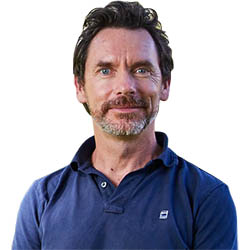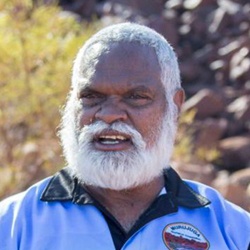Keynote Speakers

Professor Alistair Paterson
Complicating Contact: Archaeology Across Humanity’s Last Great Global Interface

Denis Rose
William Bell
A Journey Through Time
Denis Rose has worked with many Archaeologists since 1974 when he commenced employment as a Sites Record Officer in the newly established Archaeological and Aboriginal Relics Office in Victoria. I am going to speak of my experiences throughout the years concluding with the successful inscription of the Budj Bim Cultural Landscape on the UNESCO World Heritage List in 2019.
There have been many changes, mostly positive, over the years in the way that Archaeologists have interacted with Traditional Owners and vice versa. My presentation will highlight a few examples of these interactions, the good and the not so good, and is based on personal observations. These examples include; the early days of the Archaeological and Aboriginal Relics Office; managing cultural heritage in Discovery Bay Coastal Park; Alcoa Aluminium Smelter and the Onus v. Alcoa High Court decision; Gariwerd Rock Art management in the 1990s and the Budj Bim Cultural Landscape World Heritage listing

Peter Jeffries

Amy Stevens
Risk vs Reward: The Relative Value of World Heritage Listing
The concept of risk vs reward is a familiar one for archaeologists who’s roles involve decisions that impact on the evidential remains left by our ancestors’ actions and information in times past. The decision to pursue World Heritage for Murujuga seems like an easy one, and there is no doubt that World Heritage Listing of a property is a sensible way to ensure universal recognition of its values and the long-term protection of its physical properties. The process of pursuing World Heritage Listing however, raises serious questions about how inherently colonial institutions and regulatory processes can recognise and protect Indigenous values as well as scientific and archaeological values. A case study at Murujuga examines how World Heritage Listing and the focus on protection of physical attributes comes with risk to significant intangible values, agency and decision making over country in accordance with cultural tradition.

Professor Alistair Paterson
Multi-award winning archaeologist and researcher
Professor Alistair Paterson is an archaeologist, Australian Research Council (ARC) Future Fellow and professor at the UWA School of Social Sciences. His research examines the historical archaeology of colonial coastal contact and settlement in Australia’s North West and the Indian Ocean.
Professor Paterson’s key interests lie in Western Australian and Indian Ocean history, Aboriginal Australia, historical archaeology, the Dutch East India Company and its shipwrecks, colonialism and exploration, rock art, and the history of collecting in Western Australia.
Originally from Tasmania, Professor Paterson completed his undergraduate studies at the University of Melbourne before starting work in eastern Turkey. He later travelled to Sydney, NSW, to complete a PhD on Central Australia before landing in Perth and UWA in 1999, where he set up a historical archaeology program. Since his arrival, Professor Paterson has been consumed by research prospects in Western Australia, heavily focused on situating the State in bigger stories of encounter, discovery, European colonisation and indigenous history. He is currently developing the research project ‘Collecting the West’ which looks at the history of WA’s collections, in partnership with the WA Museum, the WA Art Gallery, the State Library and British Museum. The output from ‘Collecting the West’ feeds into his Future Fellowship examining North West Australia through historical archaeology.

Denis Rose
Denis Rose is a Gunditjmara traditional owner from South West Victoria, and has had a long involvement in natural and cultural heritage management. He is employed at Gunditj Mirring Traditional Owners Aboriginal Corporation as a Program Manager and manages the Budj Bim Cultural Landscape which was inscribed on UNESCO’s World Heritage List in July 2019. The development of the Budj Bim Cultural Landscape World Heritage nomination was first proposed in 2002. In 1982 Denis commenced as a trainee Ranger with the Victorian National Parks Service in south west Victoria, then moved to the Mallee and then to Gariwerd (Grampians National Park).
William Bell
Bill Bell is a Gunditjmara Traditional Owner and is employed at Gunditj Mirring Traditional Owners Aboriginal Corporation as a Cultural Heritage Officer. Bill is also an Authorised Officer under the Victorian Aboriginal Cultural Heritage Act.

Peter Jeffries
Peter Jeffries is the CEO of Murujuga Aboriginal Corporation. Peter is a Pinikura man who has lived in the Pilbara region of Western Australia for his entire life. He is well respected on the Pilbara Law grounds and has a wealth of professional experience which includes roles with the WA Police Force, Rio Tinto, the Yamatji Marlpa Aboriginal Corporation, Woodside and his own business offering consulting services and Aboriginal cultural tourism. As CEO of MAC, Peter has played a key role in creating a stable and sustainable Corporation to ensure that traditional owners and custodians have a strategic role in the management of Murujuga land and sea country.

Amy Stevens
Amy Stevens is the Heritage Research Manager at Murujuga Aboriginal Corporation. Amy is a Darug woman who first began working in the Pilbara approximately 20 years ago. She is an archaeologist and social researcher, specialising in heritage management and the social justice outcomes of heritage practice. Amy has worked in various roles across Australian heritage and Aboriginal social justice for 20 years as a consultant, heritage manager, senior policy advisor and research director in Aboriginal policy. As Heritage Research Manager of MAC, Amy is currently working with the WA State Government to draft the World Heritage nomination for the Murujuga Cultural Landscape.
Have a question
Contact Us
Contact the Conference Organiser, Julie Jerbic
0402 189 948
Email Here
AAA Website